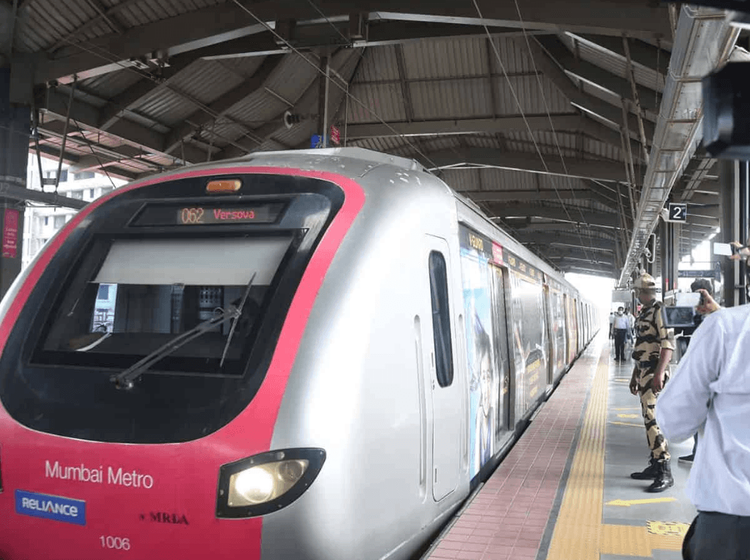Mumbai's traffic is infamous worldwide, and its public transportation system is equally inadequate. It is a common occurrence to witness passengers clinging onto the open doorways of trains and buses, leading to frequent accidents.
To address this issue, a new metro network has been introduced, aiming to alleviate street congestion and rail lines overcrowding. Currently, three lines are operational, but a significant milestone will be achieved this December when the Aqua Line, a crucial fourth line connecting Mumbai's southern island to its northern suburbs, opens. By 2030, the entire metro system is expected to cover a distance nearly equivalent to the aging suburban rail network and cater to 11 million passengers, surpassing the current 8 million served by the railway.
Why do we need Aqua Line?
Considering Mumbai's population exceeds 22 million and continues to grow, the introduction of a metro system is long overdue. It arrives in India's financial capital approximately a century after New York, three decades after Shanghai, and two decades after New Delhi. The extensive 14-line network spanning 360 kilometers (224 miles) is anticipated to reverse the three-decade decline in public transport usage within Mumbai. The Aqua Line alone is projected to divert 85% of its commuters from road travel.
The scarcity of available land, particularly in southern Mumbai, has hindered the expansion of the existing above-ground train and bus networks. The current rail system carries approximately three times the number of passengers originally intended, posing regular risks to commuters.
According to local media reports citing railway data, over 700 fatalities occurred last year alone due to individuals falling from moving trains or being struck on the tracks.
Result Of The Aqua Line
The Aqua Line is a crucial step towards achieving the goals of faster access between south and north Mumbai.
Currently, the journey by car from residential north to southern business districts takes about one hour, but with the Aqua Line, it is expected to take only 15 to 25 minutes underground.
Building the Aqua Line has been a long and bureaucratic process.
Ashwini Bhide, the managing director of the Mumbai Metro Rail Corp., is responsible for the construction of the Aqua Line, which will be entirely underground and cost an estimated 373 billion rupees ($4.5 billion).
In Kalbadevi, a commercial district in Mumbai, there are two large excavations next to a crowded street filled with old British-era buildings, bustling markets, high rises, and heavy traffic.
Constructing a metro station in Kalbadevi required acquiring residential buildings, relocating families, and rebuilding their homes after the infrastructure was in place.
These construction-related disruptions led to protests from locals, causing delays in the project.
Bhide was temporarily removed from her position due to opposition from citizen groups regarding tree felling in a forested suburb where the metro control center is being constructed.
Bhide considers the Aqua Line as one of the most challenging projects in the country due to the extensive underground tunneling and construction required in densely populated urban areas.
Apart from Kalbadevi, the Aqua Line will connect five other business districts, the state government headquarters, the Dharavi slum, and the city's two airport terminals.
The route also intersects with the existing suburban rail corridor and upcoming metro lines in the northern part of the city.
Bhide believes that the Aqua Line will bring major change to Mumbai by connecting currently unconnected areas and central business districts that generate significant employment.
The Aqua Line is expected to transform the commuting style of Mumbai.
Attracting Riders
Bhide stated that the metro network aims to increase the share of public transport rides to 75%, up from the current 65%.
This goal will be put to the test, particularly in terms of how the metro authorities plan and manage last-mile connectivity. It is likely that riders will require additional services such as short-distance buses or shared cab routes to complete their journeys. Covered and underground walkways may also be implemented to encourage ridership, especially during the heavy monsoon rains that typically flood Mumbai between June and August each year.
Bhide, who holds a senior position in the city's municipal corporation mentioned that:
The station access points have been constructed above a flood line determined from 100 years of rainfall data. Teams are actively working on developing intermodal and last-mile connectivity solutions.
These plans involve redesigning specific city bus routes and establishing underground connections between metro stations and large residential or commercial complexes. However, Bhide emphasized that these initiatives will be implemented gradually over time.
Future of Mumbai Transport
The 14-line metro network aims to reverse the declining share of public transport.
The metro system will alleviate the burden on the suburban rail and enhance accessibility, even if convincing drivers to give up the convenience of cars or two-wheelers remains a challenge.
Stations will be equipped with elevators and escalators, and there will be an increase in women-only compartments on trains.
According to the Asian Development Bank's 2021 report, the metro has the potential to make the city more equitable, safer, and cleaner.
The development of metro connectivity is driving new property development in Mumbai, as Karan Singh Sodi, the managing director of the Mumbai Metropolitan Region at Jones Lang LaSalle Inc., an international commercial real estate services company.
Intersections or transit stations will serve as new development hotspots over the next 10 to 20 years, attracting interest from private equity funds and corporate developers in acquiring land parcels in those areas.
pic credit: www.siasat.com
